
- •Preface
- •Content
- •Tissues
- •Nerve Tissue
- •Skin - Epidermis
- •Skin - Dermis
- •Skin - Glands
- •Subcutaneous Layer
- •Skeleton
- •Axial Skeleton
- •Cranium
- •Cranial Bones – Inferior Nasal Concha
- •Vertebral Column
- •Sacrum and Coccyx
- •Ribs
- •Sternum
- •Clavicle
- •Scapula
- •Humerus
- •Ulna
- •Radius
- •Metacarpals and Phalanges
- •Pelvis - Male
- •Femur
- •Tibia
- •Fibula
- •Tarsal Bones - Cuboid and Navicular
- •Phalanges
- •Patella
- •Skeletal Muscles
- •Transversospinales Muscles
- •Cervical Hypaxial Muscles
- •Thoracic and Abdominal Hypaxial Muscles
- •Shoulder Muscles - Rotator Cuff
- •Shoulder Muscles - Prime Movers
- •Anterior Brachial Muscles
- •Posterior Brachial Muscles
- •Posterior Thigh Muscles
- •Thigh Muscles
- •Lateral Leg Muscles
- •Posterior Leg Muscles
- •Spinal Nerves
- •Dorsal Rami
- •Intercostal Nerves
- •Cutaneous Nerves
- •Autonomic Nerves
- •Spinal Cord
- •Brain
- •Cerebrum
- •Cerebellum
- •Meninges
- •Hypothalamus
- •Pituitary Gland
- •Pineal Gland
- •Thymus
- •Pancreas
- •Ovaries
- •Testes
- •Blood
- •Heart
- •Lymphatics
- •Larynx
- •Lungs
- •Cast of Trachea and Bronchial Tree
- •Esophagus
- •Stomach
- •Pancreas
- •Large Intestine
- •Mesenteries
- •Omenta
- •Female Reproductive Organs
- •Ovary
- •Vagina
- •Ductus Deferens and Spermatic Cord
- •Penis
- •Index
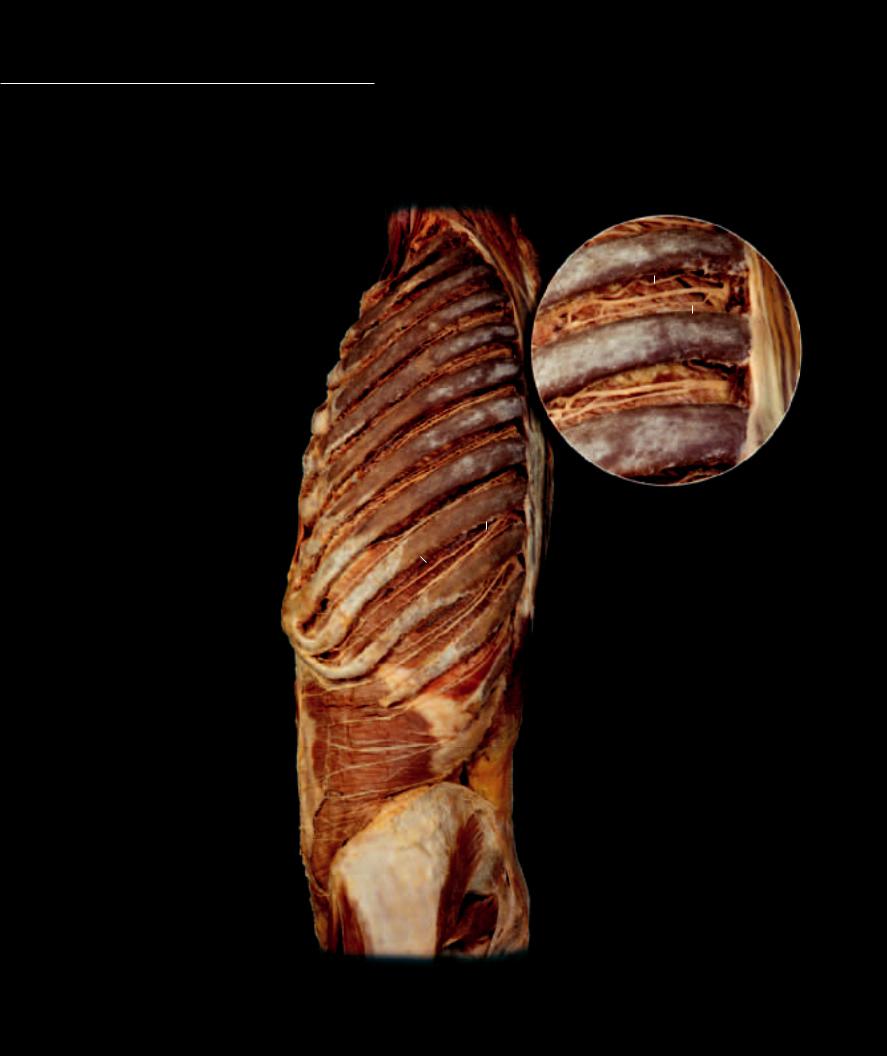
Unlike the ventral rami in the cervical, lumbar, and sacral regions, which form plexuses, most of the thoracic ventral rami remain segmental like their dorsal counterparts. These thoracic ventral rami, called the inter-
costal and subcostal nerves, emerge from the spinal nerve trunk and enter the intercostal space just inferior to each of the twelve ribs. Each of these segmental nerves has a similar structural design. The main trunk of the nerve runs through the intercostal space, with the segmental arteries and veins, between the middle and internal muscle layers of the body wall. Accompanying the main branch is a smaller collateral branch, which emerges from the main branch near the angle of the rib, and runs inferior to the main branch through the intercostal space. The main branch also gives rise to lateral and anterior cutaneous branches that supply the skin, or dermatome, of each segment.
Intercostal Nerves |
6 |
|
|||
1 |
Main trunk |
|
|
|
|
|
|
|
|||
2 |
Collateral branch |
1 |
|||
Other Nerves and Structures |
|
|
|
||
|
|
|
|||
2 |
|||||
3 |
Subcostal nerve |
||||
|
|
|
|||
4 |
Iliohypogastric nerve |
|
|
|
|
5 |
Posterior intercostal vein |
|
|
|
|
6 |
Posterior intercostal artery |
|
|
|
|
7 |
Innermost intercostal muscle |
|
|
|
|
8 |
Transversus abdominis muscle |
|
|
|
|
9 |
Gluteus medius muscle |
|
|
|
|
10Piriformis muscle
11Iliocostalis muscles
12Rib 12
6
Dissection of intercostal space
Lateral view
5
7
7
12
11
3
4
8
9
10
Dissection of intercostal nerves
Lateral view
220
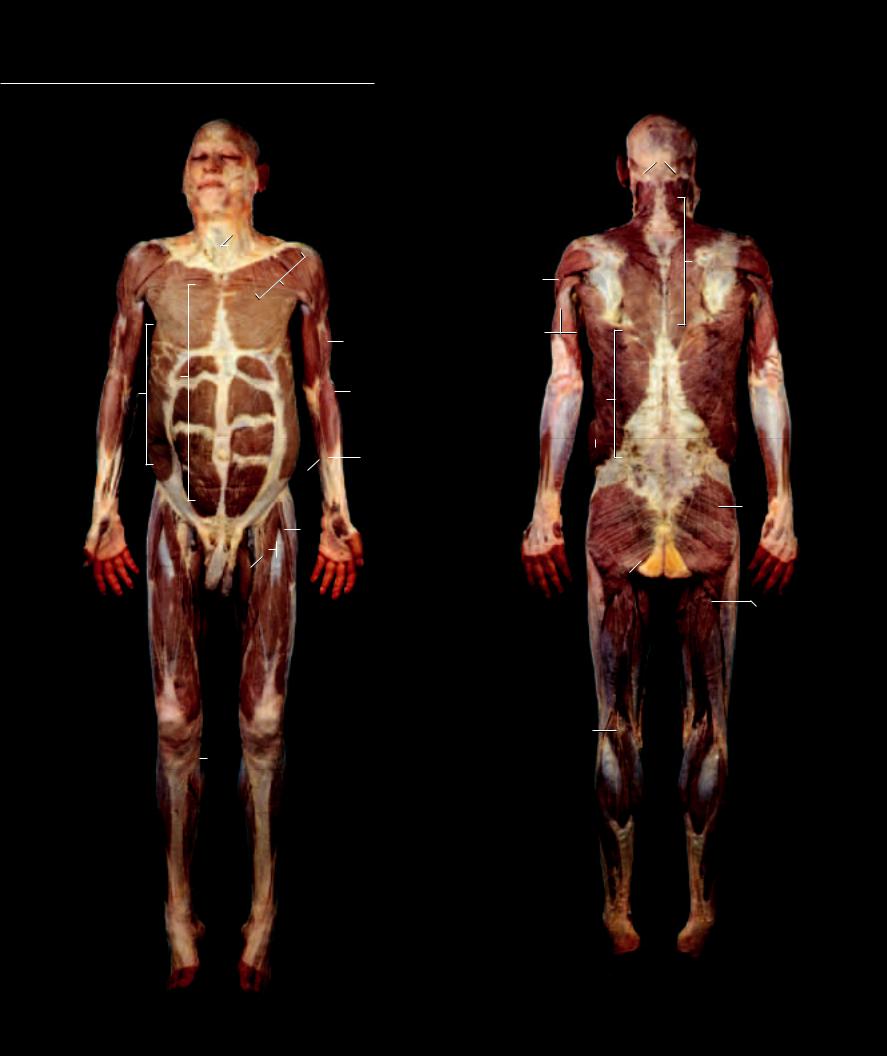
Cutaneous Nerves Many small nerves, named cutaneous nerves, branch from the spinal and cranial nerves and course through and between muscles to emerge
into the integumentary covering of the body. These detailed dissections reveal all the cutaneous nerves of the body.
|
|
|
|
|
|
|
|
|
|
1 |
|
Greater occipital nerve |
||||||||||
|
|
|
|
|
|
|
|
|
|
2 |
|
Transverse cervical nerves |
||||||||||
|
|
|
|
|
|
|
|
|
|
3 |
|
Supraclavicular nerves |
||||||||||
|
|
|
|
|
|
|
|
|
|
4 |
|
Medial cutaneous branches (dorsal rami) |
||||||||||
|
|
|
|
|
|
|
|
|
|
5 |
|
Lateral cutaneous branches (dorsal rami) |
||||||||||
|
|
|
|
|
|
|
|
|
|
6 |
|
Anterior cutaneous branches (ventral rami) |
||||||||||
2 |
|
7 |
|
Lateral cutaneous branches (ventral rami) |
||||||||||||||||||
|
|
|||||||||||||||||||||
|
|
|
|
|
|
|
|
|
|
|
|
|
|
|||||||||
|
|
|
|
|
|
|
|
|
|
3 |
|
|
|
|
8 |
|
|
|||||
|
|
|
|
|
|
|
|
|
|
|
|
|
|
|
|
|||||||
|
|
|
|
|
|
|
|
|
|
|
|
|
|
9 |
|
|
||||||
|
|
|
|
|
|
|
|
|
|
|
|
|
|
|
|
|
|
|
|
|||
|
|
|
|
|
|
|
|
|
|
|
|
|
|
|
|
|
|
|
|
|||
|
|
6 |
|
|
|
|
|
|
|
|
|
|
|
|
|
|
10 |
|
|
|
||
|
|
|
|
|
|
|
|
|
|
|
|
|
|
|
|
|
|
|
||||
|
|
|
|
|
|
|
|
|
|
|
|
|
|
|
|
11 |
|
|
||||
|
|
|
|
|
|
|
|
|
|
|
|
|
|
|
|
|
||||||
7 |
|
|
|
|
|
|
|
|
|
|
|
|
|
|
|
|
|
|
|
|
||
|
|
|
|
|
|
|
|
|
|
|
|
|
|
|
|
|
|
|
|
|||
|
|
|
|
|
|
|
|
|
|
13 |
|
|
|
|
|
12 |
|
|
||||
|
|
|
|
|
|
|
|
|
|
|
|
|
|
|
||||||||
|
|
|
|
|
|
|
|
|
|
|
|
|
|
|
|
|
|
|||||
|
|
|
|
|
|
|
|
|
|
|
|
|
|
17 |
|
|
|
|
|
|
|
|
|
|
|
|
|
|
|
|
|
|
|
|
|
|
|
|
|
|
|
|
|
|
|
|
|
|
|
|
|
|
|
|
|
|
|
|
|
|
|
|
|
|||||
|
|
|
|
|
|
|
|
|
|
|
|
|
|
|
|
|
|
|
|
|
|
|
|
|
|
|
|
|
|
|
|
|
|
|
|
|
|
|
|
|
|
|
|
|
|
|
|
|
|
|
|
|
|
|
|
|
|
|
|
|
|
|
|
|
|
|
|
|
|
|
|
|
|
|
|
|
|
|
14 |
|
|
|
|
|
|
|
|
|
|
||
|
|
|
|
|
|
|
|
|
|
16 |
|
|
|
|
|
|
|
|
|
|
|
|
|
|
|
|
|
|
|
|
|
|
8 |
|
Superior lateral brachial cutaneous nerves |
||||||||||
|
|
|
|
|
|
|
|
|
|
9 |
|
Posterior brachial cutaneous nerves |
||||||||||
|
|
|
|
|
|
|
|
|
|
10 |
|
Inferior lateral brachial cutaneous nerves |
||||||||||
|
|
|
|
|
|
|
|
|
|
11 |
|
Posterior antebrachial cutaneous nerve |
||||||||||
|
|
|
|
|
|
|
|
|
|
12 |
|
Lateral antebrachial cutaneous nerve |
||||||||||
|
|
|
|
|
|
|
|
|
|
13 |
|
Medial antebrachial cutaneous nerve |
||||||||||
|
|
|
|
|
|
|
|
|
|
14 |
|
Femoral branch of genitofemoral nerve |
||||||||||
|
|
|
|
|
|
|
|
|
|
15 |
|
Lateral cutaneous branch of subcostal nerve |
||||||||||
|
|
|
|
|
|
|
|
|
|
16 |
|
Anterior cutaneous branch of femoral nerve |
||||||||||
|
|
|
|
|
|
|
|
|
|
17 |
|
Lateral femoral cutaneous nerve |
||||||||||
|
|
|
|
|
|
|
|
21 |
18 |
|
Superior cluneal nerves |
|||||||||||
|
|
|
|
|
|
|
|
19 |
|
Inferior cluneal nerve |
||||||||||||
|
|
|
|
|
|
|
|
|
|
|
||||||||||||
|
|
|
|
|
|
|
|
|
|
|
|
|
|
|
|
20 Posterior femoral cutaneous nerve |
||||||
|
|
|
|
|
|
|
|
|
|
21 |
|
Saphenous nerve |
||||||||||
|
|
|
|
|
|
|
|
|
|
|
|
|
|
|
|
22 Lateral sural cutaneous nerve |
||||||
1
4
5
15
18
19
20
22
Dissections exposing cutaneous nerves
Anterior view to left, Posterior view to right
221
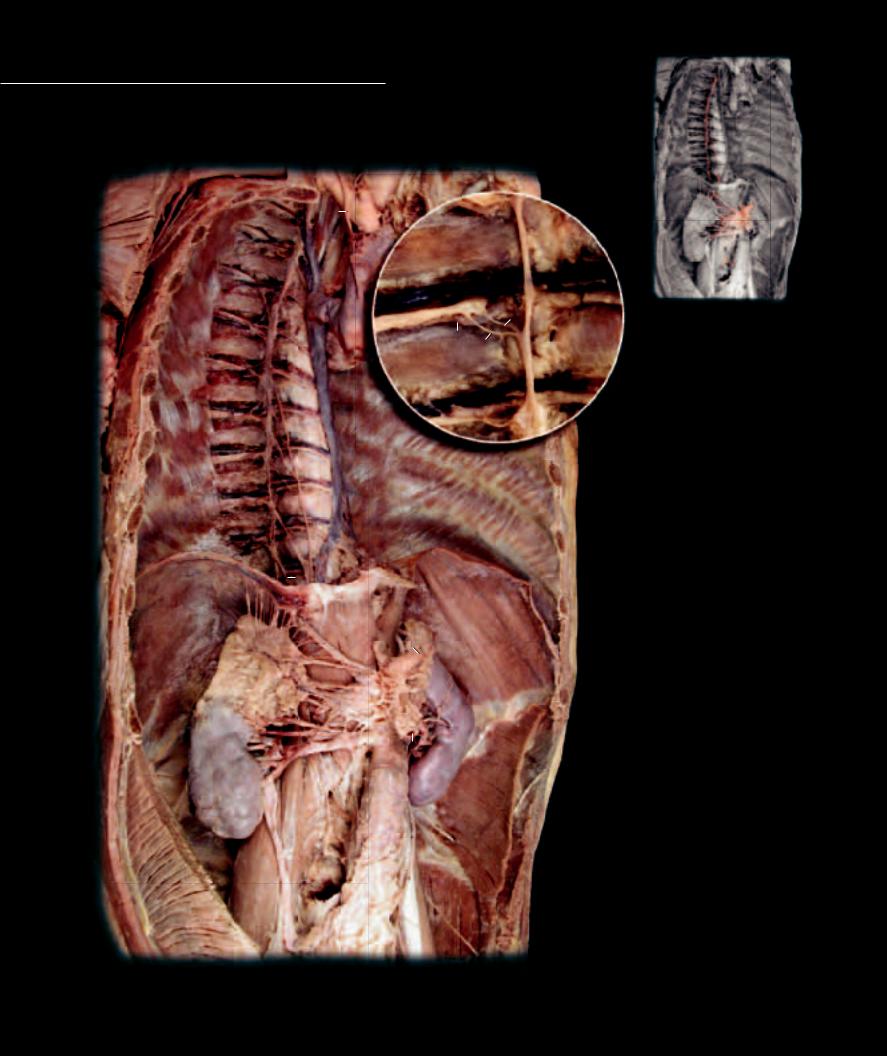
In contrast to the somatic branches of the spinal nerve, the visceral branches leave the body wall to form nerve pathways that
enter the body cavities. Within the cavities these nerves form the autonomic nerve pathways, sympathetic and parasympathetic, to the viscera. The autonomic nerves relay input signals from the wall of the tubular gut and other viscera, while carrying output signals to smooth muscle,
10
1 |
20 |
|
19 |
|
||
|
|
|
||||
32 |
|
|
17 |
|
|
|
|
21 |
22 |
|
|
|
|
|
|
|
|
|||
|
18 |
4 |
|
|||
|
|
|
|
|||
|
|
|
|
|
|
|
2 |
|
|
|
|
|
|
|
|
|
|
|
19 |
18 |
|
|
|
17 |
|
|
|
32
33
5
6
|
31 |
|
30 |
24 |
|
|
|
|
27 |
|
|
|
7 |
|
|
8 |
|
|
28 |
|
26 |
9 |
|
25 |
||
|
23 |
|
28
37
35
29
34 |
36 |
|
1
3
2
Autonomic Nerves
1 Sympathetic trunk nerve
2 Sympathetic trunk ganglion
3 White communicating ramus
4 Gray communicating ramus
5 Greater splanchnic nerve
6 Lesser splanchnic nerve
7 Coeliac ganglion
8 Superior mesenteric ganglion
9 Aorticorenal ganglion
10Vagus nerve
11Recurrent laryngeal nerve
12Anterior vagal trunk
13Posterior vagal trunk
14Inferior cardiac plexus
15Pulmonary plexus
16Esophageal plexus
Other Structures
17Intercostal nerve
18Posterior intercostal artery
19Posterior intercostal vein
20Right superior intercostal vein
21Azygous vein
22Superior vena cava
23Aorta
24Celiac trunk
25Superior mesenteric artery
26Renal artery
27Suprarenal gland
28Kidney
29Ureter
30Diaphragm
30 Esophageal hiatus
32Subcostal muscle
33Innermost intercostal muscle
34Internal oblique muscle
35Transversus abdominis muscle
36Psoas major muscle
37Psoas minor muscle
Deep dissection of sympathetic nerves, callout of communicating rami
Anterolateral view
222

cardiac muscle, and glands. Some of the autonomic nerves even rejoin the somatic pathways to supply the blood vessels and glands of the body wall. The sympathetic pathways are primarily associated with vascular smooth muscle control, and the parasympathetic pathways are principally responsible for the regulation and control of gut tube smooth muscle and glands. The sympathetic nerves are depicted on the opposite page, while the vagus nerve, which carries 75% of the parasympathetic output, is shown below as it follows the derivatives of the gut tube.
|
|
|
53 |
|
|
10 |
|
|
38 |
|
10 |
|
|
|
|||
|
|
54 |
|||
|
|
||||
|
|
|
|||
45 |
|
||||
|
|
|
|||
47 |
46 |
|
|
||
11 |
39 |
|
|
||
|
|
|
|
48 |
||||
|
49 |
|
|
|
|
|
|
|
44 |
|
|
|
|
|
|
|
|
|
23 |
11 |
|
|||||
|
|
|
|
|
|
|||
|
|
|
|
|
|
|
|
55 |
|
|
|
|
|
||||
|
|
|
|
50 |
||||
50 |
|
|
|
41 |
||||
|
|
|
|
|
|
|
|
|
|
|
|
|
15 |
|
|
||
|
|
|
|
51 |
||||
|
51 |
|
|
|
|
|
|
|
|
43 |
|
|
|
|
|
||
|
13 |
|
|
|
|
16 |
||
|
|
|
|
|
||||
|
|
|
|
|
|
|||
|
|
|
|
|
||||
12
52
30
Thoracic dissection revealing vagus nerve
Anterior view
38Thyroid gland
39Trachea
40Principal bronchus
41Lobar bronchus
42Segmental bronchus
43Esophagus
44Lung
45Right common carotid artery
46Left common carotid artery
47Right subclavian artery
48Left subclavian artery
49Brachiocephalic artery
50Pulmonary arteries
51Pulmonary veins
52Inferior vena cava
53Cricothyroid muscle
54Anterior scalene muscle
55Ligamentum arteriosum
|
45 |
|
|
|
|
|
38 |
|
|
10 |
||||
|
|
|
|
|
|
|
||||||||
|
|
|
|
|
|
|
|
|
||||||
|
|
|
|
|
|
|
|
|
|
|
|
|||
|
10 |
|
|
|
|
|
|
|
|
|
|
54 |
||
|
|
|
|
|
|
|
|
|
|
|
|
|
|
|
|
|
|
|
|
|
|
|
|
|
|
|
|
|
|
|
47 |
|
|
|
|
|
46 |
|
|
|
||||
|
11 |
|
|
|
|
|
|
|
|
|||||
|
|
|
|
|
|
|
|
|
|
|
|
|||
|
|
|
|
|
|
|
|
|
48 |
|
|
|
||
|
44 |
|
|
|
39 |
|
|
|
|
|
|
|
||
|
|
|
|
|
|
|
|
|
|
|
|
|||
|
|
|
|
|
|
|
|
|
23 |
|
|
|
||
|
41 |
|
|
|
|
|
|
|
|
11 |
|
|
||
|
40 |
|
|
|
|
|
|
|
|
|
|
|||
|
|
|
|
|
|
|
|
|
|
|
|
|
|
|
|
|
|
|
|
14 |
|
|
|
|
41 |
||||
|
|
|
|
|
|
|
|
|
|
|
|
|||
|
42 |
|
|
|
|
|
|
|
|
|
|
|
||
|
|
|
|
51 |
|
|
|
43 |
|
|
|
51 |
|
|
|
|
|
|
|
|
|
|
|
|
|
|
|
||
|
|
|
|
|
|
|
|
|
|
|
|
|
|
|
|
|
|
|
13 |
|
|
|
|
|
|
|
|
|
|
|
|
|
|
|
|
|
|
|
|
|
|
|
|
|
30 |
|
|
|
52 |
|
|
|
12 |
|
|
|
|
|
|
|
|
|
|
|
|
|
|
|
|
|
|
|
||
|
|
|
|
|
|
|
|
|
|
|
|
|
|
|
Deeper thoracic dissection revealing vagus nerve
Anterior view
223
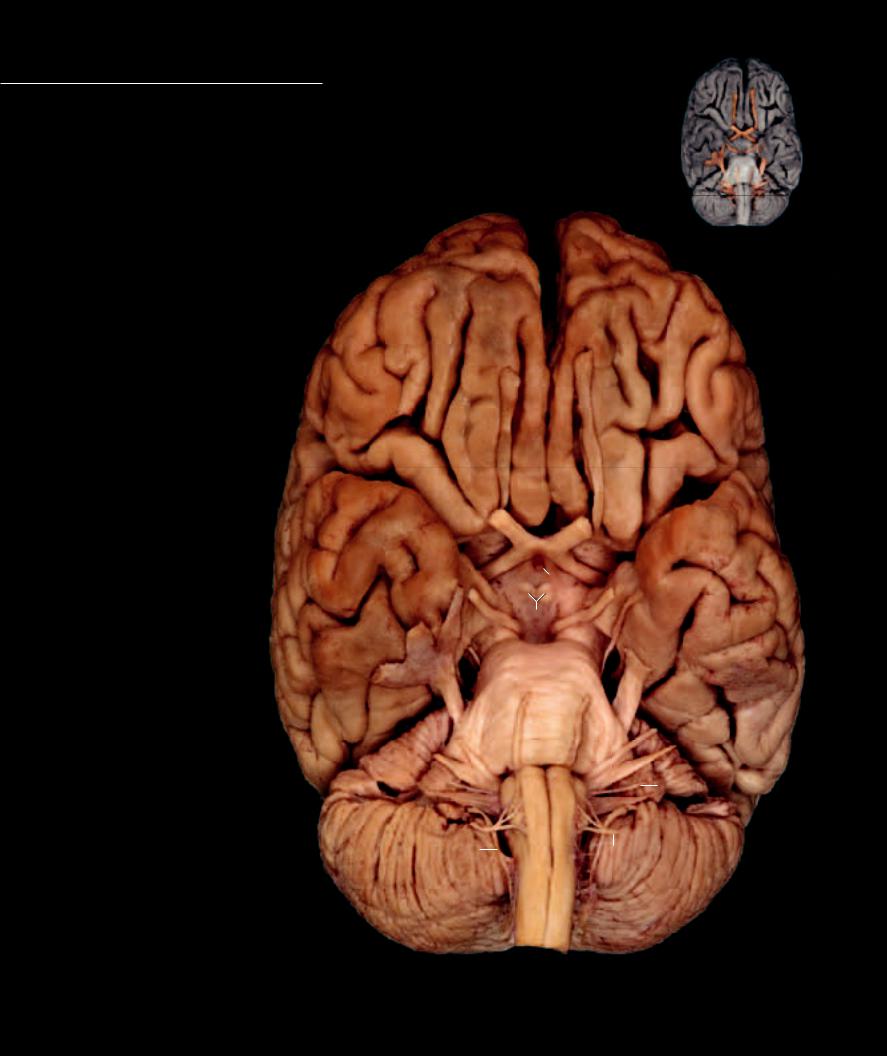
Cranial nerves segregate into three distinct groups based on associations they form during development. In number there are twelve cranial nerves, which originate in pairs
from a rostral to caudal sequence from the brain. The fi rst category, the special sensory cranial nerves, are afferent pathways established between the the brain and the special sensory structures of the nose, eye, and ear. The second category, the ventral or somitic motor cranial nerves, are homologous with the ventral roots of the spinal nerves. They originate from the brainstem as efferent pathways to somitic skeletal muscles within the head. The fi nal category, comprising the largest of the
Special Sensory Nerves 1 Olfactory nerve
2 Optic nerve
3 Vestibulocochlear nerve
Somitic Motor Nerves |
|
|
|
|
|
|
|
|
4 |
Occulomotor nerve |
|
|
27 |
|
|
|
|
5 |
Trochlear nerve |
|
|
|
|
|
|
|
|
|
|
|
|
|
|
||
6 |
Abducens nerve |
|
|
|
|
|
|
|
7 |
Hypoglossal nerve |
|
|
|
|
|
|
|
Pharyngeal Arch Nerves |
|
|
|
|
|
|
|
|
8 |
Trigeminal nerve |
|
|
|
|
|
|
|
9 |
Trigeminal ganglion |
|
|
17 |
|
|
|
|
10 |
Opthalmic branch |
|
|
|
|
|
|
|
|
|
|
|
|
|
|
||
11 |
Maxillary branch |
|
|
|
|
|
|
|
12 |
Mandibular branch |
|
|
|
|
|
|
|
13 |
Facial nerve |
|
|
|
|
|
|
|
14 |
Glossopharyngeal nerve |
|
|
1 |
|
|
|
|
15 |
Vagus nerve |
|
|
|
|
|
|
|
|
|
|
|
|
|
|
||
16 |
Accessory nerve |
|
|
|
|
|
|
|
Other Structures |
|
|
|
|
|
|
|
|
17 |
Olfactory bulb |
|
|
|
|
|
|
|
18 |
Optic chiasm |
|
|
2 |
|
|
|
|
19 |
Optic tract |
|
|
|
|
|
|
|
|
|
18 |
|
|
|
|||
20 |
Infundibulum |
|
|
|
|
|
||
21 |
Mammillary bodies |
28 |
|
19 |
|
|
|
|
22 |
Cerebral peduncle |
|
20 |
|
|
|
||
|
|
|
|
|
||||
23 |
Pons |
|
|
|
|
|
|
|
24 |
Cerebellum |
|
10 |
|
|
4 |
|
|
|
|
|
|
|
||||
25 |
Medulla oblongata |
|
21 |
|
|
|||
26 |
Spinal cord |
|
|
|
|
5 |
|
|
11 |
|
22 |
|
|
|
|
||
27 |
Frontal lobe |
|
|
|
|
|
||
|
|
|
|
|
|
|
||
28 |
Temporal lobe |
|
9 |
|
|
|
|
|
29 |
Insular lobe |
12 |
23 |
|
|
|
||
|
|
|
|
|||||
30 |
Parietal lobe |
|
|
|
|
|||
|
8 |
|
|
|
|
|
||
31 |
Occipital lobe |
|
|
|
|
|
|
|
32 |
Right lateral ventricle |
|
|
|
|
|
|
|
33 |
Choroid plexus |
|
|
|
|
6 |
|
|
34 |
Falx cerebri |
|
|
|
|
|
|
|
|
|
|
|
13 |
|
|
||
35 |
Falx cerebelli |
|
|
|
|
|
|
|
36 |
Straight sinus |
|
|
3 |
|
|
|
|
37 |
Superior sagittal sinus |
|
|
|
|
|
14 |
|
|
|
|
|
|
|
|||
38 |
Corpora quadrigemina |
|
|
25 |
|
|
||
|
|
|
||||||
|
|
|
|
|
||||
39 |
Pineal gland |
|
|
|
|
15 |
|
|
40Third ventricle
41Fourth ventricle
42 |
Geniculate ganglion |
24 |
16 |
|
|
|
|
7 |
|||||
43 |
Anterior cerebral artery |
|
|
|
||
|
|
|
|
|
||
44Internal carotid artery
45Levator palpebrae superioris muscle
46Superior rectus muscle
47Lateral rectus muscle
48 |
Superior oblique muscle |
26 |
49 |
Nasociliary nerve |
|
50 |
Long ciliary nerve |
|
51 |
Ciliary ganglion |
Base of brain with cranial nerves |
52 |
Eye |
Inferior view
224

cranial nerves, are those cranial nerves associated with the pharyngeal arches. The dorsal or pharyngeal arch cranial nerves are developmentally similar to the dorsal roots of the spinal nerves. These fi ve dorsal cranial nerves form the general sensory afferent pathways from the peripheral tissues of the head. However, because these nerve pathways coursed through the specialized arches forming the pharyngeal wall of the foregut, they established parasympathetic efferent pathways to the glandular tissue of the gut wall, along with motor efferent pathways to the skeletal muscles derived from the pharyngeal arch tissues.
|
|
|
|
|
|
|
|
27 |
|
|
|
|
|
|
|
|
|
|
34 |
|
29 |
28 |
|||
|
|
|
|
|
|
|
|
|||||
|
|
|
|
|
|
|
|
|
|
|
|
30 |
|
|
49 |
|
|
|
|
|
|
|
|
||
45 |
|
|
|
|
|
17 |
43 |
|
|
|
|
33 |
|
|
|
|
|
|
|
|
|
||||
|
|
|
|
|
|
|
|
|
|
|||
|
|
|
|
|
|
|
|
|
|
|||
|
|
|
|
|
48 |
|
|
|
|
|
32 |
|
|
|
|
|
|
|
|
40 |
|
||||
|
|
|
|
|
46 |
1 |
|
18 |
|
|
||
52 |
|
|
|
|
|
|
|
|
||||
|
|
|
|
|
|
|
2 |
|
|
|
|
|
|
|
|
|
|
|
|
|
|
|
|
|
|
|
|
|
|
|
|
|
|
39 |
|
|||
|
|
|
|
|
47 |
|
4 |
|
|
44 |
|
31 |
|
|
|
|
|
|
|
|
|
||||
|
|
|
|
|
|
38 |
||||||
51 |
50 |
|
|
|
||||||||
|
|
|
5 |
|
||||||||
|
|
|
|
|
|
|
|
|
||||
|
|
|
|
|
|
11 |
10 |
6 |
|
|
|
34 |
|
|
|
|
|
|
|
||||||
|
|
|
|
|
|
|
|
|
|
|||
|
|
|
|
|
|
|
|
|
|
|
||
|
|
|
|
|
|
|
|
|
|
|
|
36 |
98
12 |
|
|
41 |
37 |
|||||
13 |
|||||||||
|
|
|
|
||||||
42 |
|
|
|
3 |
|
|
|
24 |
|
|
|
|
|
|
|
||||
|
|
|
|||||||
|
|
|
15 |
|
|
|
|||
|
|
|
|
|
|
|
|||
14 |
|
|
|
7 |
|
||||
|
|
|
|
35 |
|||||
|
|
|
|||||||
|
|
|
|
|
|
|
|
||
|
|
|
|
16 |
|
|
|||
|
|
|
|
|
|
|
|||
Intracranial dissection of cranial nerves
Posterolateral view
225
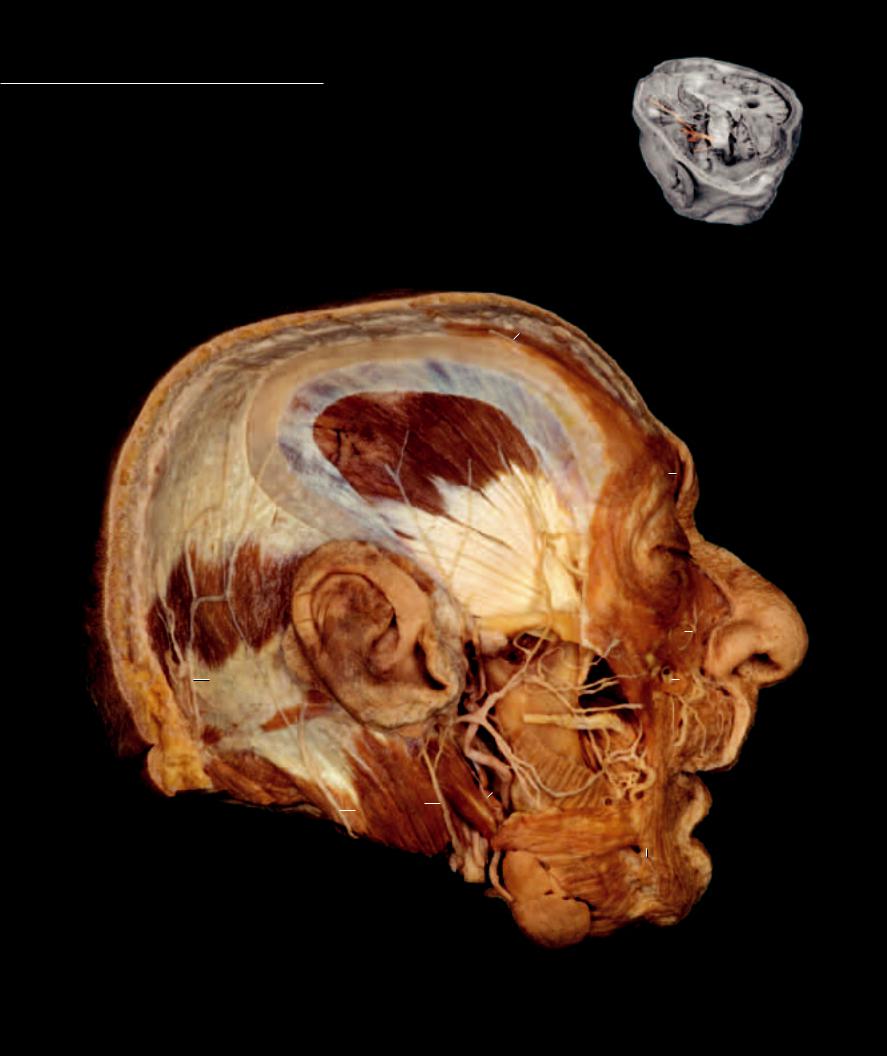
Cranial nerves V and VII, the trigeminal and facial nerves respectively, have the most extensive distribution to the tissues of the head. This page
and the three pages that follow depict the peripheral distribution of many of the branches of the trigeminal and facial nerves.
Trigeminal Nerve |
9 |
Superior posterior lateral nasal branch |
16 |
Buccal branches |
|
1 |
Auriculotemporal nerve |
10 |
Inferior posterior lateral nasal branch |
17 |
Mandibular branches |
2 |
Supraorbital nerve |
11 |
Pharyngeal branch |
18 |
Cervical branch |
3 |
Infraorbital nerve |
12 |
Lesser palatine nerve |
|
|
4 |
Mental nerve |
13 |
Greater palatine nerve |
Other Nerves and Structures |
|
5 |
Maxillary branch |
|
|
19 |
Greater occipital nerve |
6 |
Nerve of the pterygoid canal |
Facial Nerve |
20 |
Lesser occipital nerve |
|
7 |
Pterygopalatine ganglion |
14 |
Temporal branches |
21 |
Great auricular nerve |
8 |
Nasopalatine nerve (cut) |
15 |
Zygomatic branches |
22 |
Auricularis posterior muscle |
2
24
25
26
27
2
|
|
|
|
|
|
28 |
|
|
|
1 |
|
|
|
|
|
||||
23 |
|
|
|
|
14 |
3 |
|
||
|
|
|
|
|
|||||
|
|
|
|
|
|
|
|
|
|
19 |
|
|
|
|
15 |
29 |
|
3 |
|
|
|
|
|
|
|||||
|
|
|
|
|
|
|
|
|
|
22 |
|
|
|
|
|
34 |
|
|
|
|
|
|
|
|
|
|
|
|
|
|
|
|
|
|
|
31 |
|
|
|
|
|
|
|
|
35 |
16 |
|
|
|
|
|
|
|
|
|
|
|
|
|
33 |
18 |
32 |
|
|
|
||||
|
|
|
|
||||||
21 |
|
|
17 |
|
|
|
|
||
|
|
|
|
|
|
||||
|
|
20 |
|
|
|
|
|
|
|
|
|
|
|
|
|
||||
30
4
36
Dissection of head exposing branches of the facial nerve
Lateral view
226
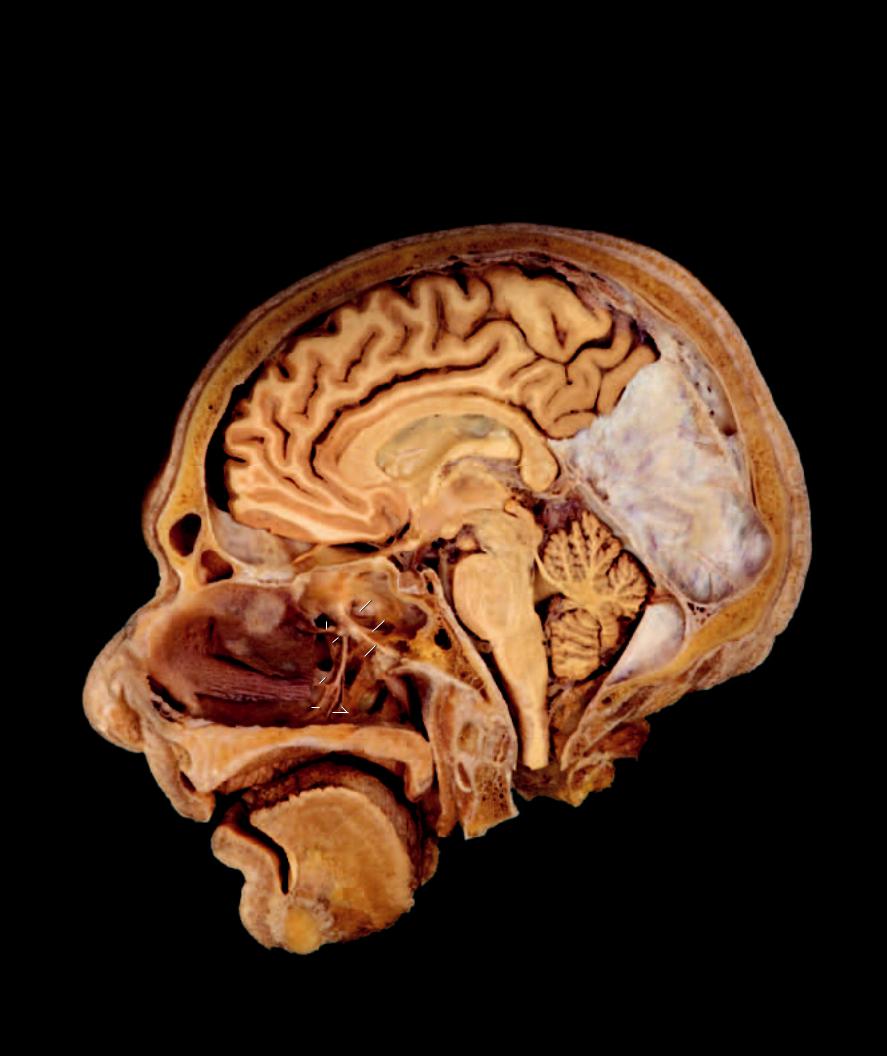
23 |
Occipital belly of epicranius muscle |
32 |
Masseter muscle |
41 |
Septum pellucidum |
50 |
Pituitary gland |
24 |
Galia aponeurotica |
33 |
Posterior digastricus muscle |
42 |
Thalamus |
51 |
Torus tubarius |
25 |
Frontal belly of epicranius muscle |
34 |
Parotid duct |
43 |
Midbrain |
52 |
Maxillary sinus |
26 |
Temporal fascia |
35 |
External carotid artery |
44 |
Pons |
53 |
Middle nasal concha |
27 |
Temporalis muscle |
36 |
Submandibular gland |
45 |
Cerebellum |
54 |
Inferior nasal concha |
28 |
Orbicularis oculi muscle |
37 |
Frontal sinus |
46 |
Fourth ventricle |
55 |
Hard palate |
29 |
Zygomaticus major muscle |
38 |
Cerebrum |
47 |
Choroid plexus |
56 |
Soft palate |
30 |
Risorius muscle |
39 |
Falx cerebri |
48 |
Medulla oblongata |
57 |
Uvula |
31 |
Buccinator muscle |
40 |
Corpus callosum |
49 |
Spinal cord |
58 |
Tongue |
38
|
|
|
|
|
|
|
|
40 |
|
|
|
|
|
|
|
|
|
41 |
39 |
|
|
|
|
|
|
|
|
|
|
|
|
|
|
|
|
|
|
42 |
|
37 |
|
|
|
|
|
|
|
|
43 |
|
|
|
|
|
|
|
|
50 |
46 |
|
|
|
|
|
|
|
5 |
|
|
|
|
|
|
|
|
|
44 |
45 |
|
|
|
|
|
|
|
|
|
||
|
8 |
|
|
|
6 |
47 |
|||
|
|
7 |
|
|
|||||
|
|
|
|
|
|
|
|
|
|
|
|
|
|
|
|
|
|
|
|
53 |
9 |
|
|
|
|
|
|||
52 |
|
|
11 |
|
|
||||
|
|
|
|
|
|||||
|
10 |
|
|
48 |
|||||
|
|
|
|
||||||
54 |
|
|
|
|
|
|
|
51 |
|
|
13 |
|
|
|
|
|
12 |
|
|
|
|
|
|
|
|
|
|
||
|
|
|
|
|
|
|
|
|
|
55 |
56 |
|
|
|
49 |
|
57 |
|
58 |
Parasagittal section and dissection of head exposing branches of the trigeminal and facial nerve
Medial view
227
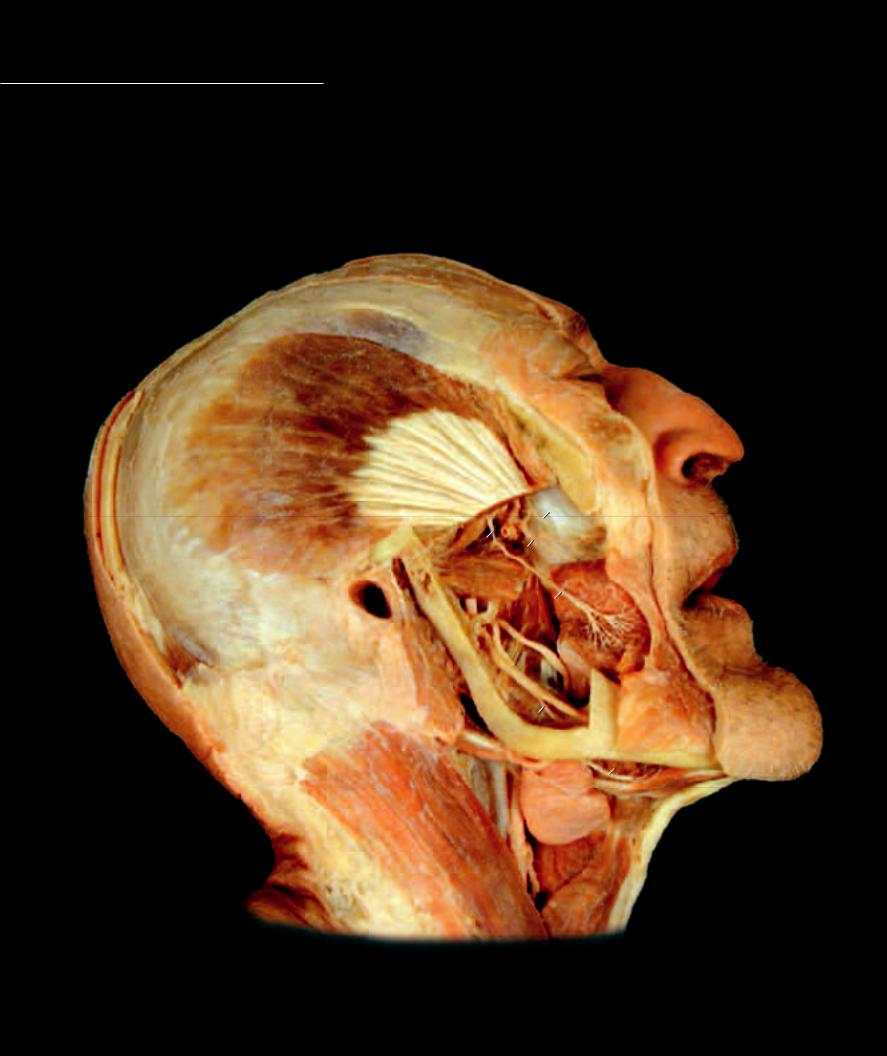
Cranial Nerves
1 |
Nerve to temporalis muscle |
7 |
Inferior alveolar nerve |
13 |
Superior laryngeal nerve |
2 |
Buccal nerve |
8 |
Nerve to mylohyoid muscle |
|
|
3 |
Middle superior alveolar nerve |
9 |
Pterygopalatine ganglion |
Other Structures |
|
4 |
Posterior superior alveolar nerve |
10 |
Infraorbital nerve |
14 |
Orbicularis oculi muscle |
5 |
Lingual nerve |
11 |
Hypoglossal nerve |
15 |
Temporal fascia |
6 |
Chorda tympani nerve |
12 |
Submandibular ganglion |
16 |
Temporalis muscle |
15
16 |
14 |
3
1
4
17
19
35 |
2 |
18
5
7
8
20
8
21
31
32
22
30 23
24
Dissection of head exposing branches of the trigeminal nerve
Lateral view
228
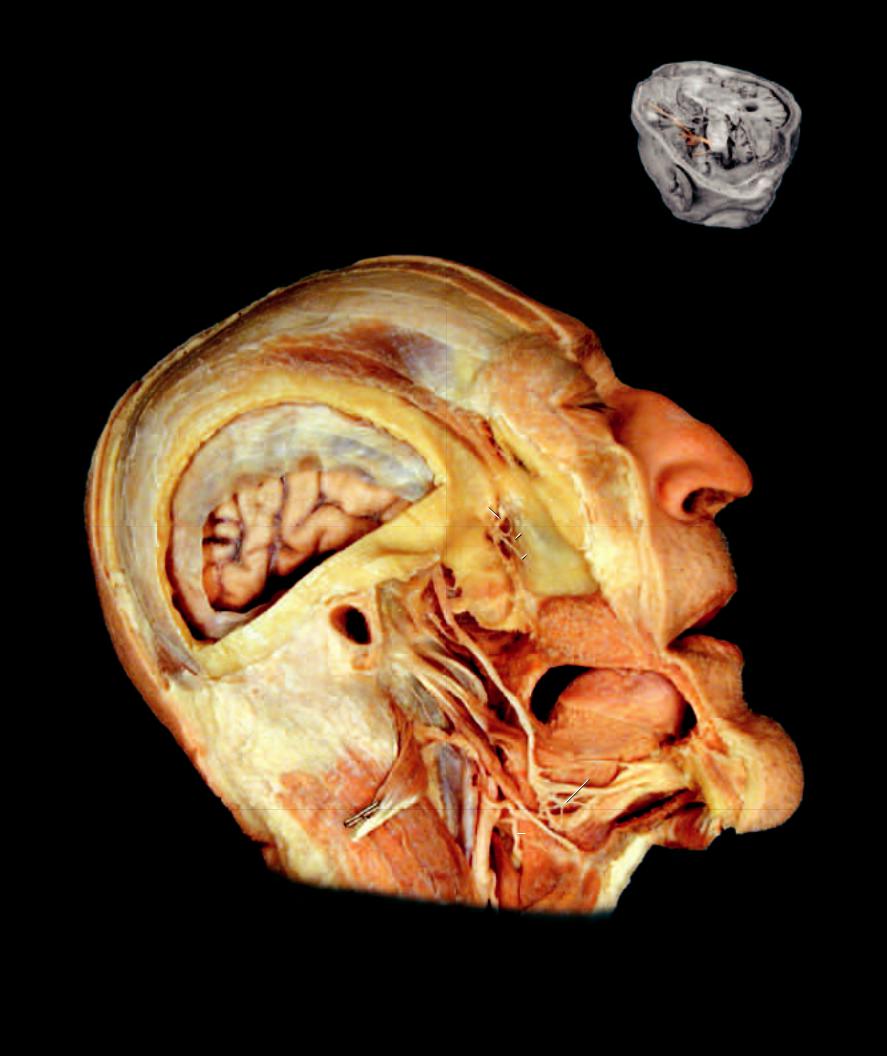
17 |
Lateral pterygoid muscle |
24 |
Omohyoid muscle |
31 |
Internal jugular vein |
18 |
Medial pterygoid muscle |
25 |
Styloglossus muscle |
32 |
Common carotid artery |
19 |
Buccinator muscle |
26 |
Stylohyoid muscle |
33 |
Dura mater |
20 |
Posterior digastricus muscle |
27 |
Geniohyoid muscle |
34 |
Cerebrum |
21 |
Anterior digastricus muscle |
28 |
Mylohyoid muscle |
35 |
External acoustic meatus |
22 |
Sternocleidomastoid muscle |
29 |
Superior pharyngeal constrictor |
36 |
Tongue |
23 |
Thyrohyoid muscle |
30 |
Inferior pharyngeal constrictor |
|
|
15
16
14
33
34 |
10 |
9 3
4
6 |
5 |
|
|
|
|
35 |
|
|
|
|
|
|
|
29 |
|
|
19 |
|
|
|
|
|
|
|
|
|
|
|
36 |
|
26 |
25 |
|
|
|
|
|
|
|
|
|
20 |
|
|
|
|
12 |
|
|
|
|
|
|
|
31 |
11 |
|
|
27 |
|
|
|
|
13 |
28 |
|
32 |
|
|
21 |
|
|
|
|
|||
|
|
|
|
||
22 |
|
|
23 |
|
|
|
|
30 |
|
||
|
|
|
|
24 |
|
|
|
|
|
|
|
Dissection of head with mandible removed
Lateral view
229
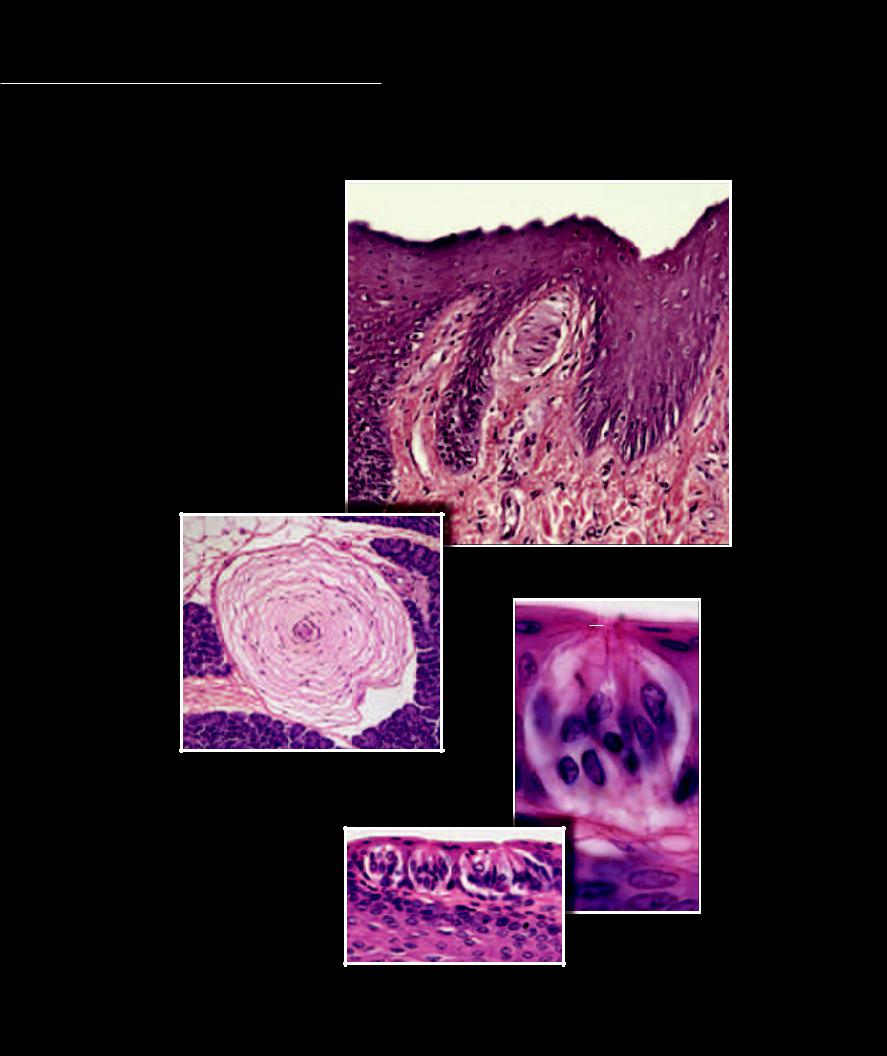
Sensory receptors are the transducers of the nervous system; that is, they convert the different types of energy we experience such as mechanical energy (touch, pressure, sound waves, etc.), thermal
energy (heat), chemical energy (taste, smell), and electromagnetic energy (light) into the electrical energy of the nervous impulse. They do this by facilitating the depolarization of the peripheral terminals of the sensory neurons. This initiates the nervous impulse along the sensory neuron, and this input is carried by the sensory neuron to the processing centers of the brain and spinal cord, which will be the topic of the next chapter.
1 |
Epidermis |
|
|
|
2 |
Corpuscle of touch (Meissner’s) |
1 |
|
|
3 |
Dermis |
|
||
|
|
|||
4 |
Dermal papilla |
|
|
|
5 |
Neuron |
|
|
|
6 |
Lamellated corpuscle |
|
|
|
7 |
Taste bud |
4 |
2 |
|
8 |
Taste pore |
|||
|
||||
9 |
Gustatory hair |
|
|
10Gustatory receptor cell
11Supporting cell
12Basal cell
3
|
|
Photomicrograph of corpuscle of touch |
||
|
|
200x |
||
|
|
8 |
||
5 |
6 |
9 |
|
|
|
|
|||
|
|
|
||
|
|
|
|
|
|
|
10 |
||
Photomicrograph of lamellated corpuscle |
11 |
|
||
100x |
|
12 |
||
|
7 |
|
|
|
Photomicrographs of taste bud
200x (left), 700x (right)
230
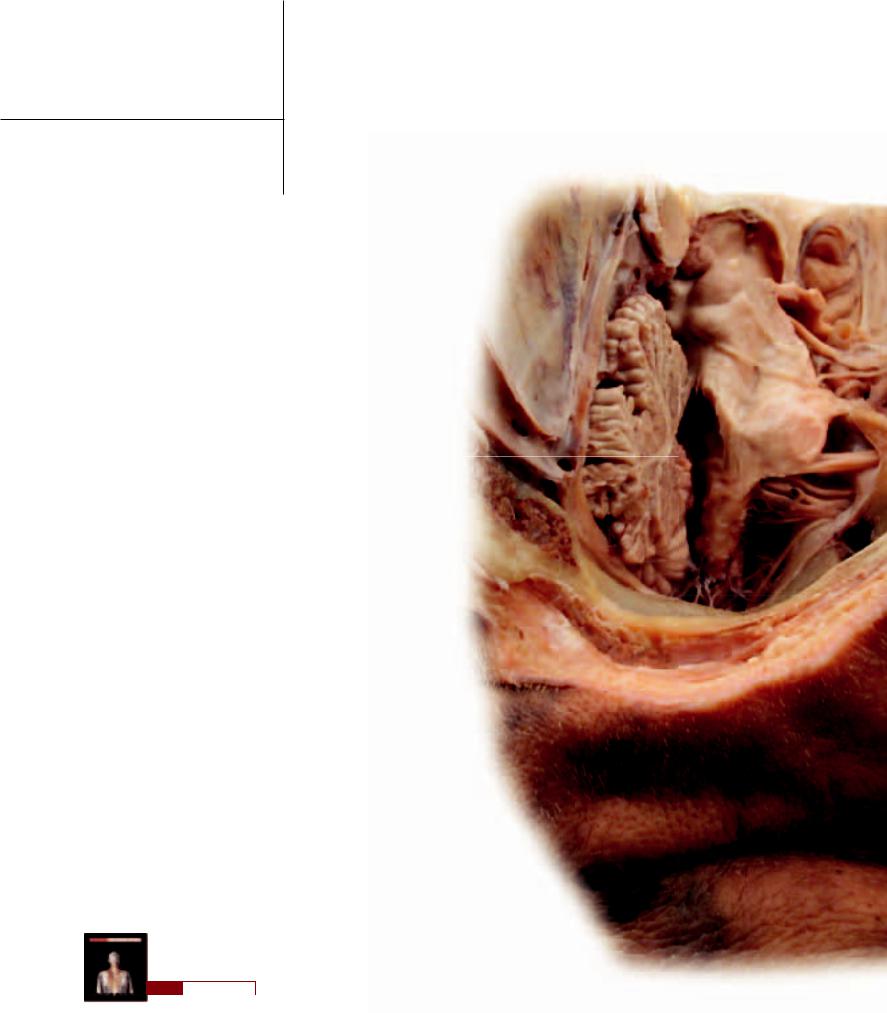
14 Central Nervous System
While the neuronal circuitry of the central nervous system is awe inspiring to say the least, the basic concepts behind this complex integration and control center have a simple design. At its simplest, the fundamental design of the central nervous system involves two features: gray matter and white matter.
The gray matter centers represent the synaptic integration and control circuits; that is, these centers contain numerous highly dendritic interneurons along with the cell bodies of efferent neurons and axon terminals of incoming afferent neurons, all forming a myriad of synaptic circuits. In these gray centers input is integrated, compared, sensed, and stored to give rise to coordinated, controlled output. The white matter, on the other hand, represents conduction tracts between the synaptic gray centers. These white tracts consist mainly of the myelinated axons of interneurons relaying signals from one gray center to another.
A second simple concept to keep in mind is that the complexity of the central nervous system increases from a caudal to cranial direction. There is logic to this pattern because in the spinal cord the gray centers primarily function as integration networks that regulate input and output for their specific spinal nerve levels. In other words, they are segmental control centers. Input entering a spinal nerve level initiates reflexive output back to the peripheral tissues at that same spinal level. Connecting these segmental gray centers via interneuronal tracts leads to greater association between neighboring levels, therefore improving integration and control. If one segmental gray center can relay information received from its center to neighboring centers, then there can be a greater spread of control generated in response to local segmental input. Now take this a step further by relaying information via white tracts from each of the segmental control centers to higher centers. These higher centers receive in-
put from all the lower segmental centers, integrating the input to gain a full body perspective, while generating the necessary output signals to exert coordinated full body control. Because of this added circuitry the cranial or brain end of the central nervous system increases in size. This additive accumulation of interconnected gray centers accounts for the structure of the brain and its amazing functional properties.
Because much of the central nervous system circuitry is of a more microscopic nature and beyond the scope of this book. In this chapter we attempt to depict the basic gross anatomy of the central nervous system and its protective coverings.
Find more information about the central nervous system in
R E A L A N AT O M Y
231
